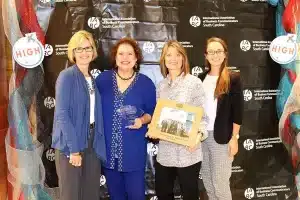NP Strategy received two prestigious communications awards at the International Association of Business Communicators (“IABC”) S.C. Chapter’s 2017 Palmetto Awards on November 2. The awards, Award of Excellence in Issues Management and Crisis Communications and Award of Merit in Digital Communication, recognize the NP Strategy team’s work for select clients over the past year.
The issues management and crisis communications award recognizes NP Strategy’s quick and detailed response to a negative social media and communications situation prompted by Hurricane Matthew’s destruction in October 2016. The strategic response plan mitigated the false information circulating social media and navigated NP Strategy’s client to a quick and favorable resolution with concerned community stakeholders.
“It’s an honor to serve our clients each day in such dynamic, individualized ways,” said Heather (Hoopes) Matthews, NP Strategy Director. “These awards highlight the results of collaboration and commitment that NP Strategy highly values.”
The second award recognizes NP Strategy’s development and rollout of the new website for OceanaGold’s Haile Gold Mine Operation. The historic gold mine’s website reflects the innovative operations on-site with an adaptive interface and content that reflects some of the mine’s key values: environmental responsibility, community involvement and commitment to safety.
The 2017 Palmetto Awards is an annual event hosted by IABC S.C. Awards recognize excellence in communication strategy, planning and execution. In total, over 40 awards were presented for nearly 100 submissions from organizations around South Carolina. An international judging panel reviewed all submissions.
